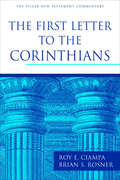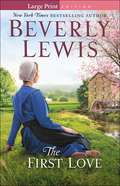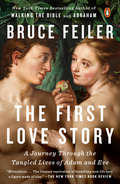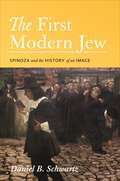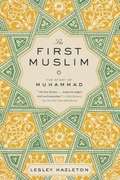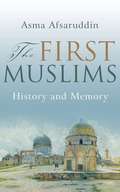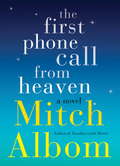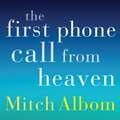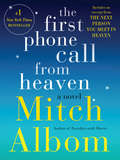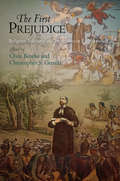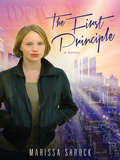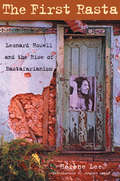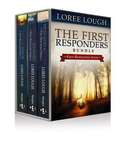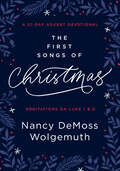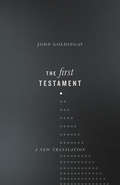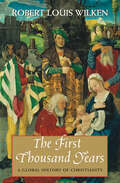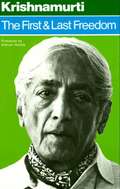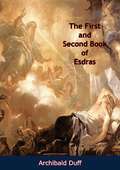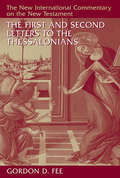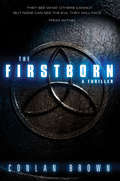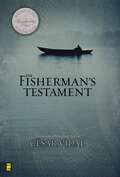- Table View
- List View
The First Letter to the Corinthians (The Pillar New Testament Commentary (PNTC))
by Brian S. Rosner Roy E. CiampaThis careful, sometimes innovative, mid-level commentary touches on an astonishingly wide swath of important, sensitive issues — theological and pastoral — that have urgent resonances in twenty-first-century life. Roy Ciampa and Brian Rosner reveal how 1 Corinthians directly addresses the claims of unity and truth, church discipline, sexual matters, the Lord’s supper, the nature of love, Christian leadership, and many other significant topics.Those who preach and teach 1 Corinthians will be grateful to Ciampa and Rosner for years to come and scholars will be challenged to see this letter with fresh eyes.
The First Love
by Beverly LewisIt's the summer of 1951, and Maggie Esh is in need of some hope. Sweet-spirite and uncommonly pretty despite struggling with illness, she is used to being treated kindly by the young men of her Old Order Amish church district. Yet Maggie wishes she were more like other courting-age girls so she could live a normal, healthy life. When tent revival meetings come to the area, the words of the preacher cause her to reconsider what she knows about faith. Can she learn to trust God even when hope seems a distant dream?
The First Love Story: Adam, Eve, and Us
by Bruce FeilerFrom the New York Times bestselling author of Walking the Bible and Abraham comes a revelatory journey across four continents and 4,000 years exploring how Adam and Eve introduced the idea of love into the world, and how they continue to shape our deepest feelings about relationships, family, and togetherness.Since antiquity, one story has stood at the center of every conversation about men and women. One couple has been the battleground for human relationships and sexual identity. That couple is Adam and Eve. Yet instead of celebrating them, history has blamed them for bringing sin, deceit, and death into the world. In this fresh retelling of their story, New York Times columnist and PBS host Bruce Feiler travels from the Garden of Eden in Iraq to the Sistine Chapel in Rome, from John Milton’s London to Mae West’s Hollywood, discovering how Adam and Eve should be hailed as exemplars of a long-term, healthy, resilient relationship. At a time of discord and fear over the strength of our social fabric, Feiler shows how history’s first couple can again be role models for unity, forgiveness, and love. Containing all the humor, insight, and wisdom that have endeared Bruce Feiler to readers around the world, The First Love Story is an unforgettable journey that restores Adam and Eve to their rightful place as central figures in our culture's imagination and reminds us that even our most familiar stories still have the ability to surprise, inspire, and guide us today.From the Hardcover edition.
The First Miracle
by Jeffrey ArcherFrom the book jacket. "From one of the world's greatest storytellers, Jeffrey Archer, and featuring illustrations from renowned British artist Craigie Aitchison, here is a Christmas treasure to delight children of all ages--one in which the story of the Nativity takes an unexpected turn." [Note to readers. All paintings are described.] "In the forty-third year of the reign of the Emperor Augustus Caesar, ruler of half the known world, a mischievous thirteen-year-old Roman boy is sent on an errand by his mother. On the way he encounters all the usual sights and sounds of village life in Judaea. But that evening Bethlehem is even more crowded than usual, since his father, the governor of the province, has ordered a census so he can tax all the emperor's subjects. Then the boy comes across a sight he will never forget--a man and his pregnant wife are being turned away from an inn, and are preparing to spend the night in a stable....With a marvelous final double twist that could have come only from the pen of Jeffrey Archer, The First Miracle is destined to take its place beside Dickens's A Christmas Carol and Dylan Thomas's A Child's Christmas in Wales as, classic of the season. JEFFREY ARCHER is one of England's most leading political figures and one of the world's most successful writers. All of his story collections and novels from 1974's Not a Penny More, Not a Penny Less to 1994's Twelve Red Herrings--have been international bestsellers. CRAIGIE AITCHISON is one of Britain's most celebrated artists. He is a Royal Academician and his highly sought- after paintings appear in numerous public and private collections."
The First Modern Jew: Spinoza and the History of an Image
by Daniel B. SchwartzPioneering biblical critic, theorist of democracy, and legendary conflater of God and nature, Jewish philosopher Baruch Spinoza (1632-1677) was excommunicated by the Sephardic Jews of Amsterdam in 1656 for his "horrible heresies" and "monstrous deeds." Yet, over the past three centuries, Spinoza's rupture with traditional Jewish beliefs and practices has elevated him to a prominent place in genealogies of Jewish modernity. The First Modern Jew provides a riveting look at how Spinoza went from being one of Judaism's most notorious outcasts to one of its most celebrated, if still highly controversial, cultural icons, and a powerful and protean symbol of the first modern secular Jew. Ranging from Amsterdam to Palestine and back again to Europe, the book chronicles Spinoza's posthumous odyssey from marginalized heretic to hero, the exemplar of a whole host of Jewish identities, including cosmopolitan, nationalist, reformist, and rejectionist. Daniel Schwartz shows that in fashioning Spinoza into "the first modern Jew," generations of Jewish intellectuals--German liberals, East European maskilim, secular Zionists, and Yiddishists--have projected their own dilemmas of identity onto him, reshaping the Amsterdam thinker in their own image. The many afterlives of Spinoza are a kind of looking glass into the struggles of Jewish writers over where to draw the boundaries of Jewishness and whether a secular Jewish identity is indeed possible. Cumulatively, these afterlives offer a kaleidoscopic view of modern Jewish cultureand a vivid history of an obsession with Spinoza that continues to this day.
The First Muslim
by Lesley HazletonThe extraordinary life of the man who founded Islam, and the world he inhabited—and remade. Muhammad’s was a life of almost unparalleled historical importance; yet for all the iconic power of his name, the intensely dramatic story of the prophet of Islam is not well known. In The First Muslim, Lesley Hazleton brings him vibrantly to life. Drawing on early eyewitness sources and on history, politics, religion, and psychology, she renders him as a man in full, in all his complexity and vitality. Hazleton’s account follows the arc of Muhammad’s rise from powerlessness to power, from anonymity to renown, from insignificance to lasting significance. How did a child shunted to the margins end up revolutionizing his world? How did a merchant come to challenge the established order with a new vision of social justice? How did the pariah hounded out of Mecca turn exile into a new and victorious beginning? How did the outsider become the ultimate insider? Impeccably researched and thrillingly readable, Hazleton’s narrative creates vivid insight into a man navigating between idealism and pragmatism, faith and politics, nonviolence and violence, rejection and acclaim. The First Muslim illuminates not only an immensely significant figure but his lastingly relevant legacy. .
The First Muslim
by Lesley HazletonThe extraordinary life of the man who founded Islam, and the world he inhabited--and remade. Muhammad's was a life of almost unparalleled historical importance; yet for all the iconic power of his name, the intensely dramatic story of the prophet of Islam is not well known. In The First Muslim, Lesley Hazleton brings him vibrantly to life. Drawing on early eyewitness sources and on history, politics, religion, and psychology, she renders him as a man in full, in all his complexity and vitality. Hazleton's account follows the arc of Muhammad's rise from powerlessness to power, from anonymity to renown, from insignificance to lasting significance. How did a child shunted to the margins end up revolutionizing his world? How did a merchant come to challenge the established order with a new vision of social justice? How did the pariah hounded out of Mecca turn exile into a new and victorious beginning? How did the outsider become the ultimate insider? Impeccably researched and thrillingly readable, Hazleton's narrative creates vivid insight into a man navigating between idealism and pragmatism, faith and politics, nonviolence and violence, rejection and acclaim. The First Muslim illuminates not only an immensely significant figure but his lastingly relevant legacy.
The First Muslim
by Lesley HazletonThe extraordinary life of the man who founded Islam, and the world he inhabited--and remade.Muhammad's was a life of almost unparalleled historical importance; yet for all the iconic power of his name, the intensely dramatic story of the prophet of Islam is not well known. In The First Muslim, Lesley Hazleton brings him vibrantly to life. Drawing on early eyewitness sources and on history, politics, religion, and psychology, she renders him as a man in full, in all his complexity and vitality.Hazleton's account follows the arc of Muhammad's rise from powerlessness to power, from anonymity to renown, from insignificance to lasting significance. How did a child shunted to the margins end up revolutionizing his world? How did a merchant come to challenge the established order with a new vision of social justice? How did the pariah hounded out of Mecca turn exile into a new and victorious beginning? How did the outsider become the ultimate insider?Impeccably researched and thrillingly readable, Hazleton's narrative creates vivid insight into a man navigating between idealism and pragmatism, faith and politics, nonviolence and violence, rejection and acclaim. The First Muslim illuminates not only an immensely significant figure but his lastingly relevant legacy.
The First Muslims: History and Memory
by Asma AfsaruddinA fresh look at the origins and development of Islam, this is a fascinating reconstruction of the era of the first three generations of Muslims. Using a wealth of classical Arabic sources, it chronicles the lives of the Prophet Muhammad, his Companions, and the subsequent two generations of Muslims, together known as the "the Pious Forebears" (al-salaf al-salih). Examining the adoption in contemporary times of these early Muslims as legitimizing figureheads for a variety of causes, both religious and political, Afsaruddin tries to establish where their sympathies really lay. Essential reading for anyone interested in the inception of the Islamic Faith, this important book will captivate the general reader and student alike. Asma Afsaruddin is Associate Professor of Arabic and Islamic Studies at the University of Notre Dame, Indiana. She is the author of /Excellence and Precedence: Medieval Islamic Discourse on Legitimate Leadership/.
The First Phone Call From Heaven
by Mitch AlbomFROM THE MASTER STORYTELLER WHOSE BOOKS HAVE TOUCHED THE HEARTS OF OVER 40 MILLION READERS'Mitch Albom sees the magical in the ordinary' Cecilia Ahern__________One last chance. What would you say? When the residents of a small town on Lake Michigan start receiving phone calls from the afterlife, it becomes the subject of widespread attention. Is it the greatest miracle ever or a massive hoax?Sully Harding, a grief-stricken single father, returns to Coldwater from a stint in prison to discover his hometown gripped by 'miracle fever.' Even his young son carries a toy phone, hoping to hear from his mother in heaven.As the calls increase Sully begins to dig into the phenomenon. Determined to discover who or what is behind the mystery, he gradually begins to piece together the pieces of his broken heart. __________WHAT READERS ARE SAYING ABOUT THE FIRST PHONE CALL FROM HEAVEN'Gripping from start to finish . . . The plot twists and turns like a great mystery novel''As always, with Mitch Albom's books, the storyline is addictive, leaving the reader wanting more''Makes you see the world from a different perspective . . . A real treat for the soul''Brilliant and moving read from start to end. Superb''Beautifully constructed, thought-provoking and soulful'
The First Phone Call From Heaven
by Mitch AlbomThe First Phone Call from Heaven tells the story of a small town on Lake Michigan that gets worldwide attention when its citizens start receiving phone calls from the afterlife. Is it the greatest miracle ever or a massive hoax? Sully Harding, a grief-stricken single father, is determined to find out. An allegory about the power of belief -- and a page-turner that will touch your soul -- Albom's masterful storytelling has never been so moving and unexpected.Readers of The Five People You Meet in Heaven will recognize the warmth and emotion so redolent of Albom's writing, and those who haven't yet enjoyed the power of his storytelling, will thrill at the discovery of one of the best-loved writers of our time.
The First Phone Call From Heaven: A Novel
by Mitch Albom"What if the end is not the end?" From the beloved author of the #1 New York Times bestsellers Tuesdays with Morrie and The Five People You Meet in Heaven comes his most thrilling and magical novel yet--a page-turning mystery and a meditation on the power of human connection.One morning in the small town of Coldwater, Michigan, the phones start ringing. The voices say they are calling from heaven. Is it the greatest miracle ever? Or some cruel hoax? As news of these strange calls spreads, outsiders flock to Coldwater to be a part of it.At the same time, a disgraced pilot named Sully Harding returns to Coldwater from prison to discover his hometown gripped by "miracle fever." Even his young son carries a toy phone, hoping to hear from his mother in heaven.As the calls increase, and proof of an afterlife begins to surface, the town--and the world--transforms. Only Sully, convinced there is nothing beyond this sad life, digs into the phenomenon, determined to disprove it for his child and his own broken heart.Moving seamlessly between the invention of the telephone in 1876 and a world obsessed with the next level of communication, Mitch Albom takes readers on a breathtaking ride of frenzied hope.The First Phone Call from Heaven is Mitch Albom at his best--a virtuosic story of love, history, and belief.
The First Prejudice
by Chris Beneke Christopher S. GrendaIn many ways, religion was the United States' first prejudice--both an early source of bigotry and the object of the first sustained efforts to limit its effects. Spanning more than two centuries across colonial British America and the United States, The First Prejudice offers a groundbreaking exploration of the early history of persecution and toleration. The twelve essays in this volume were composed by leading historians with an eye to the larger significance of religious tolerance and intolerance. Individual chapters examine the prosecution of religious crimes, the biblical sources of tolerance and intolerance, the British imperial context of toleration, the bounds of Native American spiritual independence, the nuances of anti-Semitism and anti-Catholicism, the resilience of African American faiths, and the challenges confronted by skeptics and freethinkers.The First Prejudice presents a revealing portrait of the rhetoric, regulations, and customs that shaped the relationships between people of different faiths in seventeenth- and eighteenth-century America. It relates changes in law and language to the lived experience of religious conflict and religious cooperation, highlighting the crucial ways in which they molded U.S. culture and politics. By incorporating a broad range of groups and religious differences in its accounts of tolerance and intolerance, The First Prejudice opens a significant new vista on the understanding of America's long experience with diversity.
The First Principle: A Novel
by Marissa ShrockIn the not-too-distant future, the United Regions of America has formed. Governors hold territories instead of states, and while Washington, DC, is gone, the government has more control than ever before. For fifteen-year-old Vivica Wilkins, the daughter of a governor, this is life as usual. High school seems pretty much the same--until one day, that controlling power steps right through the door during study hall.When Vivica speaks out to defend her pregnant friend against the harsh treatment of Population Management Officer Marina Ward, she has no idea she's sowing the seeds of a revolution in her own life. But it isn't long before she discovers her own illegal pregnancy. Now she has to decide whether to get the mandatory abortion--or follow her heart, try to keep the baby, and possibly ruin her mother's chances at becoming president.A rebel group called the Emancipation Warriors, who are fighting to restore freedoms once held unalienable, offer her asylum. Can Vivica trust these rebels to help her or will they bring everything crashing down around her? Accepting their help may come with consequences she isn't ready to face.Marissa Shrock's debut novel crafts a chilling story of what may be to come if we allow the economic and moral crises currently facing our country to change the foundations on which we built our independence--and of the difference one person can make when they choose to trust God's lead.
The First Rasta: Leonard Howell and the Rise of Rastafarianism
by Stephen Davis Hélène LeeGoing far beyond the standard imagery of Rasta--ganja, reggae, and dreadlocks--this cultural history offers an uncensored vision of a movement with complex roots and the exceptional journey of a man who taught an enslaved people how to be proud and impose their culture on the world. In the 1920s Leonard Percival Howell and the First Rastas had a revelation concerning the divinity of Haile Selassie, king of Ethiopia, that established the vision for the most popular mystical movement of the 20th century, Rastafarianism. Although jailed, ridiculed, and treated as insane, Howell, also known as the Gong, established a Rasta community of 4,500 members, the first agro-industrial enterprise devoted to producing marijuana. In the late 1950s the community was dispersed, disseminating Rasta teachings throughout the ghettos of the island. A young singer named Bob Marley adopted Howell's message, and through Marley's visions, reggae made its explosion in the music world.
The First Responders Bundle, From Ashes to Honor, Honor Redeemed & A Man of Honor - eBook [ePub]
by Loree LoughThis bundle contains From Ashes to Honor, Honor Redeemed, A Man of Honor. From Ashes to Honor Minutes before two jumbo jets changed U.S. history, New York police officer Austin Finley ignored the call from his brother, who'd been bugging him for days. Trying to live with his one regret causes hatred and bitterness to consume Austin, and when counselor Mercy Samara recommends desk duty, Austin resigns. Haunted by her own memories of 9/11, Mercy takes a job as a school counselor in Baltimore. When Austin, now an EMT, responds to an emergency at Mercy's school, both are stunned and wary. Finally their common (and painful) memories turn suspicion into friendship, then romance. But hard questions linger: Can they truly move beyond their past harsh judgments and harsh words? Will their past finally bring them closer or farther apart? Honor Redeemed Highly skilled Search and Rescue (SAR) team leader, Honor Mackenzie, works almost as hard at guarding the dark secrets of her past as she does when training SAR dogs. As for widowed Sun reporter Matt Phillips, not even his former SAR work is as important as protecting his ten-year-old twin boys. When a jumbo jet crashes outside Baltimore one cold night, their respective jobs put them face-to-face at the grisly scene--and force Matt to come to terms with his feelings for Honor, he gets word that she hasn't reported in since starting the search for a missing child. Reverting to his SAR training, Matt leads the search team as a vicious winter storm bears down on the area. Will he find her in time? A Man of Honor On a steamy spring morning, Dusty Parker--part-time pastor, part-time search-and-rescue team member, and full-time administrator of a school for troubled boys--joins the search for a missing teenage girl. He partners with volunteer and inner-city school teacher Grace Sinclair, and what they find bonds them in ways neither could have expected. As they begin to build their lives together, a visitor from the past causes Dusty and Grace to further open their hearts and home. But a threat is looming on their seemingly perfect lives and in one terrifying night, everything changes.
The First Songs of Christmas: An Advent Devotional
by Nancy DeMoss WolgemuthLet the songs of the first Christmas turn your heart toward God&’s glory.During the holidays the musical tunes of the season are everywhere. Their nostalgic melodies warm our hearts. But the original Christmas songs are different; they lift our hearts to a holy God. They reveal the greatness, glory, and goodness of our Savior. Taking us beyond quaint imagery and feel-good lyrics, the Advent songs of the Bible unfold God&’s redemptive plan for the world and His eternal purpose for the ages.Reflecting her own love for the season, Nancy DeMoss Wolgemuth offers meditations on the first two chapters of Luke&’s gospel in The First Songs of Christmas. This 31-day Advent devotional shines new light on the ancient yet inspiring songs of Elizabeth, Mary, Zechariah, the angels, and Simeon. These readings will lead you to contemplate the loveliness and essence of Christmas. Let this book be your companion as you spend the days surrounding Christmas the way these men, women, and angels did, your gaze fixed on our great God and Savior.
The First Songs of Christmas: An Advent Devotional
by Nancy DeMoss WolgemuthLet the songs of the first Christmas turn your heart toward God&’s glory.During the holidays the musical tunes of the season are everywhere. Their nostalgic melodies warm our hearts. But the original Christmas songs are different; they lift our hearts to a holy God. They reveal the greatness, glory, and goodness of our Savior. Taking us beyond quaint imagery and feel-good lyrics, the Advent songs of the Bible unfold God&’s redemptive plan for the world and His eternal purpose for the ages.Reflecting her own love for the season, Nancy DeMoss Wolgemuth offers meditations on the first two chapters of Luke&’s gospel in The First Songs of Christmas. This 31-day Advent devotional shines new light on the ancient yet inspiring songs of Elizabeth, Mary, Zechariah, the angels, and Simeon. These readings will lead you to contemplate the loveliness and essence of Christmas. Let this book be your companion as you spend the days surrounding Christmas the way these men, women, and angels did, your gaze fixed on our great God and Savior.
The First Testament: A New Translation
by John GoldingayAwash in a sea of Bible translations, do we need yet another? Most translations bend the text toward us. They make the rough places smooth, the odd bits more palatable to our modern sensibilities. In every translation something is gained and something lost. In The First Testament: A New Translation, John Goldingay interrupts our sleepy familiarity with the Old Testament. He sets our expectations off balance by inviting us to hear the strange accent of the Hebrew text. We encounter the sinewed cadences of the Hebrew Bible, its tics and its textures. Translating words consistently, word by word, allows us to hear resonances and see the subtle figures stitched into the textual carpet. In a day of white-bread renderings of the Bible, here is a nine-grain translation with no sugar or additives. In The First Testament the language of Zion comes to us unbaptized in pious religiosity. Familiar terms such as salvation, righteousness, and holiness are avoided. We cock our ears to listen more carefully, to catch the intonations and features we had not caught before: “Yahweh said to Abram, ‘Get yourself from your country, from your homeland, and from your father’s household, to the country that I shall enable you to see, and I shall make you into a big nation. I shall bless you and make your name big and you’ll become a blessing." (Gen 12:1-2) “Hey, you who wish for Yahweh’s day. What good really is Yahweh’s day to you?— it will be darkness, not light.” (Amos 5:18) “My shepherd being Yahweh, I don’t lack; he enables me to lie down in grassy pastures. He leads me to settled water; he turns my life back.” (Ps 23:1-3) The First Testament is an invitation to read the sacred text through the eyes of one of the most accomplished Old Testament scholars in the English-speaking world today. With introductions to each book, it is an attractive translation for the classroom as much as for personal study and enjoyment. Premium Features • Limited edition • Full-cloth hardcover with two-color foil stamping • Attached bookmark ribbon
The First Thousand Years: A Global History of Christianity
by Robert WilkenHow did a community that was largely invisible in the first two centuries of its existence go on to remake the civilizations it inhabited, culturally, politically, and intellectually? Beginning with the life of Jesus, Robert Louis Wilken narrates the dramatic spread and development of Christianity over the first thousand years of its history. Moving through the formation of early institutions, practices, and beliefs to the transformations of the Roman world after the conversion of Constantine, he sheds new light on the subsequent stories of Christianity in the Latin West, the Byzantine and Slavic East, the Middle East, and Central Asia.Through a selected narration of particularly noteworthy persons and events, Wilken demonstrates how the coming of Christianity set in motion one of the most profound revolutions the world has known. This is not a story limited to the West; rather, Christian communities in Ethiopia, Nubia, Armenia, Georgia, Persia, Central Asia, India,
The First and Last Freedom
by Jiddu KrishnamurtiKrishnamurti is a leading spiritual teacher of our century. In The First and Last Freedom he cuts away symbols and false associations in the search for pure truth and perfect freedom. Through discussions on suffering, fear, gossip, sex and other topics, Krishnamurti's quest becomes the readers, an undertaking of tremendous significance.
The First and Second Book of Esdras: Edited (classic Reprint)
by Archibald DuffBefore providing helpful notes and English translations of the first and second books of Esdras, Archibald Duff gives an in-depth introduction to the books. This introduction covers the books’ origin, authorship, and intended audience. Dedicated sections explain each book’s doctrine, and Duff lays out “The Christian’s Need for Esdras 1 and 2.”-Print ed.
The First and Second Letters to the Thessalonians (The New International Commentary on the New Testament)
by Gordon D. FeeIn this commentary Gordon Fee aims first and foremost to offer a fresh exposition of the text of 1 and 2 Thessalonians. He shows the reader what is in the biblical text, what the text meant in the first century, and what it means now. Fee reveals the logic of each argument or narrative before moving on to the details of each verse, and he concludes each section with a theological-practical reflection on the meaning of the text today. Among other things, Fee explores the occasion for writing for each epistle, restoring 2 Thessalonians to the place it deserves as a full companion to the first letter, rather than merely a tagalong to 1 Thessalonians.
The Firstborn: They See What Others Cannot. But None Can See the Evil They Will Face from Within. (The Firstborn #1)
by Conlan BrownThree supernatural gifts. Two thousand years of division. One moment of truth. Hannah’s head hung, long brown hair in her eyes. Her face felt pasty with cold and fatigue and pain. Arms behind her back, she sat in a chair, wrists and ankles tied to the wooden frame, chair legs bolted to the floor. A cold car. A gun. Horror. Pain. Grief. Screaming. A windshield blistering with holes. Darkness. It all came over her like a flood. A pouring out of pictures in her mind. But then there was one more thing. Not an image, but a feeling--that half a continent away someone else had felt it all happening too. The Firstborn--three ancient religious orders gifted with the ability to see past, present, and future--have been divided since the death of Christ. But today, in an era of terrorism and globalization, it has become clear there is an atrocity coming that they must unite to prevent because it is one of them who will perpetrate it. Savage intrigue and a violent power struggle set the stage for three members of the Firstborn as they race against time through a labyrinth of deception and danger to save the lives of hundreds...
The Fisherman's Testament
by Cãesar VidalIn AD 62, Marco Junio Vitalis, a seasoned military general, is assigned to interrogate an elderly Jewish fisherman called Peter and unravels a story that shakes the very foundations of the Roman Empire. Now making its debut in English, this award-winning Spanish bestseller transports readers to ancient Rome where the stakes are high for Christ followers.
